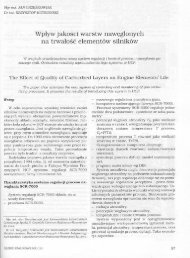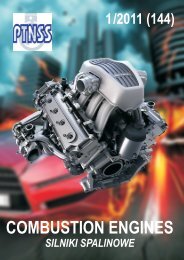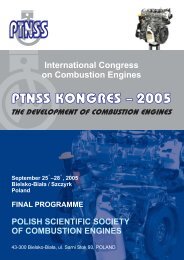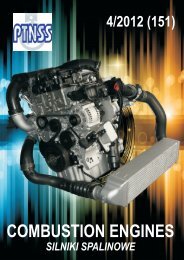Create successful ePaper yourself
Turn your PDF publications into a flip-book with our unique Google optimized e-Paper software.
Development of automotive emissions testing equipment and test methods...<br />
years in response to emissions reduction legislation (in the<br />
EU: the introduction of the Euro 5 standard’s restrictions over<br />
the years 2009/2011, and the scheduled introduction of Euro<br />
6 in 2014/2015). An additional factor is widespread pressure<br />
for the reduction of greenhouse gases, mostly by reduction<br />
of CO 2<br />
emissions, but increasingly with attention also paid<br />
to other greenhouse gases released as a result of incomplete<br />
combustion (such as CH 4<br />
) and side reactions which can occur<br />
within aftertreatment systems (such as N 2<br />
O and NO 2<br />
).<br />
Such external pressures drive research and development<br />
work on new low-emission vehicles, the use of alternative<br />
fuels, new types of engines and increasing the efficiency<br />
of engines currently produced. Thus, emissions testing –<br />
to quantify emissions of harmful compounds, CO 2<br />
, fuel<br />
consumption, as well as measurements of the efficacy of<br />
devices designed to combat such emissions – has never been<br />
more important for the industry and for the engineering and<br />
scientific communities as a whole. In addition to being a<br />
necessary requirement for the introduction of new models<br />
and conformity of production testing, such advanced research<br />
methods can provide fascinating and valuable insights into<br />
the formation of pollutants and the fluxes of heat and chemical<br />
species through a vehicle’s powertrain.<br />
Maximum emission factors in the Euro 5 standard represent<br />
a significant reduction in comparison to the Euro 4<br />
standard (decreases range from 20 to 80 per cent). Some<br />
of these maximum permissible masses per kilometre will<br />
be reduced still further upon the entry into force of Euro 6.<br />
The Euro 6 standard will require passenger cars and light<br />
commercial vehicles (LCV) to have combined emissions of<br />
HC, CO, NO x<br />
and PM of under 1 gram per kilometre (for CI<br />
engines), and 1.16 g/km (for SI engines), which presents a<br />
design challenge both in terms of engines and aftertreatment<br />
systems, and emissions analysis systems and automotive<br />
testing facilities. The lower emission factors specified in<br />
recent and future legislation require high-sensitivity detection<br />
methods, to minimize the effect caused by measurement<br />
uncertainties. This general requirement for statistical<br />
significance and accuracy is likely to be echoed in the EPA’s<br />
forthcoming ‘1065’ light duty test procedure. In addition to<br />
progressively stricter emissions limits, efforts are underway<br />
to make testing procedures more representative of real-world<br />
conditions. One effect of efforts in this area has been the<br />
introduction of cold-start testing at low ambient temperatures<br />
in EU, EPA and CARB legislation. Type approval legislation<br />
requirements for testing at –7 °C [4] and –6.7 °C [5, 6]<br />
necessitate facilities for simulation of such conditions on<br />
demand, all year round.<br />
Legislative testing requirements represent only the tip of<br />
the iceberg – reduced emissions limits necessitate research<br />
and development work in order to meet these standards.<br />
Knowledge of forthcoming emissions standards is imperative<br />
for the laboratory design process; in addition, fuel specifications<br />
and fuel quality standards, (together with megatrends<br />
such as engine downsizing and the use of alternative fuels)<br />
should be monitored in order to prepare test facilities which<br />
fully meet the needs of the industry [2, 3].<br />
tyczących redukcji emisji dwutlenku węgla (CO 2<br />
). Transport<br />
samochodowy jest jednym z największych źródeł szkodliwej<br />
emisji spalin i w ciągu ostatnich kilku lat zaobserwowano<br />
zmiany w konstrukcji silników spalinowych, będące odpowiedzią<br />
na prawne wymagania redukcji emisji (w Unii Europejskiej<br />
wprowadzenie normy Euro 5 w latach 2009/2011 i<br />
zapowiadana na lata 2014/2015 norma Euro 6). Dodatkowym<br />
czynnikiem wpływającym na zmiany konstrukcyjne pojazdów<br />
jest wzrost nacisku na redukcję gazów cieplarnianych,<br />
przede wszystkim przez obniżenie emisji CO 2<br />
, ale także<br />
przez zwrócenie uwagi na inne gazy cieplarniane wytwarzane<br />
jako efekt niecałkowitego spalania (takie, jak CH 4<br />
), a<br />
także będące wynikiem reakcji ubocznych występujących<br />
w systemie oczyszczania spalin (jak N 2<br />
O i NO 2<br />
).<br />
Powyższe czynniki ukierunkowują badania i działania<br />
rozwojowe na pracę nad nowymi pojazdami o niskiej emisji,<br />
stosowanie paliw alternatywnych, wprowadzanie nowych,<br />
bardziej ekologicznych typów silników, a także zwiększanie<br />
sprawności silników już istniejących. Wynika z tego,<br />
że jeszcze nigdy testy emisji, w których wykonywany jest<br />
pomiar wagowy i zliczanie cząstek stałych, pomiar ilości<br />
wytworzonego CO 2<br />
, zużycia paliwa, a także badań sprawności<br />
podzespołów ograniczających emisję, nie były tak<br />
istotne z punktu widzenia przemysłu i nauki. Zaawansowane<br />
metody badań emisji mogą dostarczać cennych wniosków<br />
dotyczących formowania się i przemieszczania zanieczyszczeń<br />
pochodzących od spalin silnikowych i strumieni ciepła<br />
przez jednostkę napędową pojazdu.<br />
Maksymalne limity emisji zawarte w normie Euro 5 są<br />
znacznie niższe w stosunku do poprzedniej normy Euro 4<br />
(redukcja od 20 do 80 %). Część z tych limitów (dozwolonej<br />
masy cząstek spalin na kilometr) będzie ponownie obniżona<br />
wraz z wprowadzeniem normy Euro 6. Norma ta będzie<br />
wymagała od samochodów osobowych i lekkich pojazdów<br />
użytkowych, aby łączna emisja HC, CO, NO x<br />
i cząstek stałych<br />
była poniżej 1 grama na kilometr dla pojazdów z silnikami ZS<br />
i 1,16 gram na kilometr dla samochodów z silnikami ZI, co<br />
stanowi duże wyzwanie dla konstrukcji silników, systemów<br />
oczyszczania spalin, a także dla metod i aparatury pomiarowej.<br />
Obniżanie limitów określone w aktualnych i przyszłych<br />
normach wymaga stosowania metod wykrywania związków<br />
szkodliwych cechujących się dużą dokładnością pomiaru,<br />
aby zminimalizować niepewności pomiaru. Główne wymaganie<br />
dotyczące znaczenia statystycznej analizy wyników i<br />
dokładności pomiarów będzie przedstawione przez Agencję<br />
Ochrony Środowiska USA w mającej się wkrótce ukazać<br />
procedurze ‘1065’ dla lekkich pojazdów samochodowych. W<br />
związku z coraz surowszymi normami emisji, większą wagę<br />
przywiązuje się także do tego, by testy badawcze prowadzone<br />
były w warunkach jak najbardziej zbliżonych do naturalnych.<br />
Efektem takiego podejścia stało się wprowadzanie metodyki<br />
badawczej dla samochodu przy rozruchu zimnego silnika w<br />
niskich temperaturach otoczenia w Unii Europejskiej, EPA i<br />
CARB. Wprowadzenie wymagań dla badań w temperaturze<br />
otoczenia –7 °C [4] i –6,7 °C [5, 6] zmuszają laboratoria badawcze<br />
do dostosowania się do tych warunków i posiadania<br />
możliwości prowadzenia takich badań przez cały rok.<br />
<strong>COMBUSTION</strong> <strong>ENGINES</strong>, No. 1/2013 (152)<br />
29












